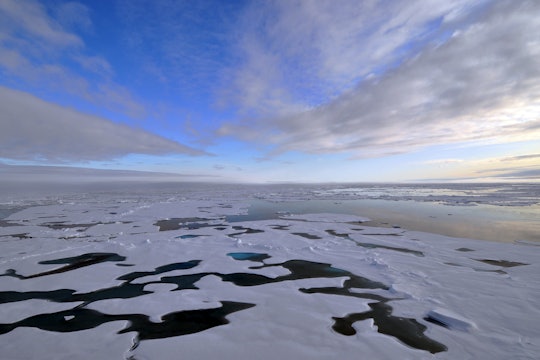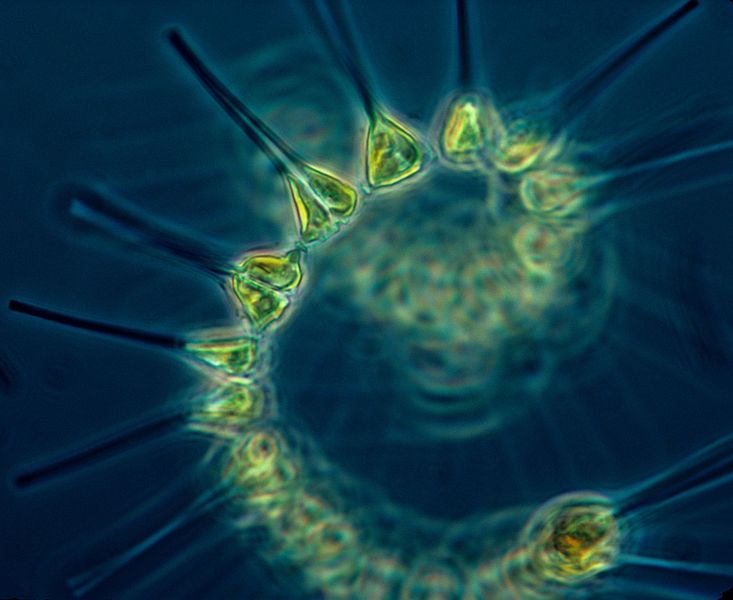
U.S. Geological Survey on Flickr
Melting sea ice gives phytoplankton the space to pump out cloud-forming gasses
With warming temperatures, microscopic plankton are creating big clouds that could further affect Arctic temperatures
Climate change is affecting the entire world, but nowhere is it felt more than in the Arctic. According to a recent IPCC report, the Arctic has already warmed by up to 5 degrees Celsius (9 degrees Fahrenheit) in the 20th century. This warming has led to melting permafrost in tundral regions, to an increased melting of the Greenland ice sheet, which is projected to raise global sea level, and, of course, to a decrease in the extent of Arctic sea ice.
One of climate change's biggest impacts impacts is on some of the smallest members of the Arctic ecosystem – phytoplankton. "Phytoplankton," a collective term for marine organisms that photosynthesize, are barely visible to the naked eye, but these small creatures produce up to half of the world's entire oxygen supply. And, as a recent study by Martí Galí and other researchers at the Université Laval in Quebec shows, they might be having an even stranger impact on Arctic climate.
Phytoplankton need two things to grow: light, and nutrients. In the Arctic Ocean, nutrients are rarely a problem. The Arctic's long winter nights, however, mean that for most of the year, Arctic phytoplankton do not have enough light to truly grow. The majority of Arctic species lie in wait for enough sunlight to trigger their growth, and when they receive that sunlight, they bloom in abundance. But in order for sunlight to reach the phytoplankton in the ocean, these plankton have to be in a part of the Arctic that isn't covered by ice. The decrease in Arctic sea ice means that regions of the Arctic Ocean are ice-free for longer periods of time, which means that Arctic phytoplankton are getting larger and larger regions in which to grow. This means an overall increase in the amount of Arctic phytoplankton, and when Arctic phytoplankton increase, so too might a certain gas in the atmosphere – DMS.

Phytoplankton form the basis of the oceanic food web
NOAA MESA Project on Wikimedia Commons
DMS stands for dimethylsulfide. At the low concentrations produced by phytoplankton, it's generally harmless. If you've gone to the beach, you've smelled DMS at some point in your life. It's a somewhat disagreeable odor, the same one produced when cooking corn, boiling cabbage, or certain types of seafood. It's a crucial component of the instantly recognizable "smell of the sea." It's produced naturally by certain types of phytoplankton, and so, it's natural to assume that as phytoplankton increase, DMS concentrations increase. But DMS is particularly interesting not just because of its odor, but because of its suspected role in producing clouds. The full extent of the link between DMS and cloud formation is still unknown, but if DMS does affect cloud formation then, Galí and his collaborators suggest, the loss of sea ice in the Arctic might actually be contributing to more Arctic clouds.
Testing whether phytoplankton in the Arctic were producing more DMS than normal wasn't straightforward, because current measurements of DMS in the atmosphere are sparse. And because travel to the Arctic is difficult, expensive, and sometimes dangerous, there are very few actual measurements of the composition of Arctic air, or the chemistry of the water. In order to estimate whether DMS concentrations were actually increasing in the region, Galí and his team had to take a wider perspective. They had to look at the region from space.
The satellites SeaWIFS and MODIS-Aqua have monitored chlorophyll-a, the pigment that gives plants their green color, in the ocean since 1997. Chlorophyll is often used as a stand-in for phytoplankton biomass – the more chlorophyll is present in the ocean, so the reasoning goes, the more phytoplankton are active. This reasoning has some issues – not all phytoplankton use chlorophyll as their main pigment, for example – but it does a good job at giving us a general idea of whether phytoplankton populations are increasing.
By combining chlorophyll measurements from the satellites with an algorithm that converts biomass to DMS emissions (by calculating how much DMS is emitted by phytoplankton on average), Galí and his team were able to estimate that DMS concentrations in the Arctic have increased by roughly 33% per decade. Taking these estimates and projecting them into the scenario of the Arctic ocean being completely ice-free in the summer, they estimated that DMS concentrations could more than double in the event of a completely ice-free summer, something projected to occur as soon as the next 25 years if climate change remains unchecked. This means that in the future, Arctic skies could have more than twice the amount of DMS they have today.
_(4971318856).jpg)
A phytoplankton bloom in the Barents Sea, on the edge of the Arctic region
Which brings us back to clouds. Currently, the link between DMS emissions and cloud formation is something we don't fully understand, but we do see that DMS does have some impact on cloud formation. If DMS concentrations in the Arctic continue to increase, it's reasonable to expect a change in cloud patterns in the Arctic. And this is important, because not only do clouds play a crucial role in regulating Earth's climate, clouds and the impact of clouds on Earth's temperature are also one of the least understood aspects of climate change. As far as we understand it, clouds can act to either cool Earth, if sunlight is reflected from the tops of clouds and back into space, or further amplify warming, if heat from the land is reflected off the bottom of clouds and back down onto the planet.
A number of factors go into whether clouds can warm or cool Earth – the altitude of clouds, how many clouds are present, and how opaque or transparent the clouds are, for example. In general, high, thin clouds tend to have a greater warming effect than a cooling effect, while low, opaque clouds tend to cool the earth more than they warm it. In the Arctic, the effect is slightly different – low clouds over the ocean tend to retain more heat in the area during most of the year.
So if cloud cover does increase in the Arctic, will the new clouds that form worsen Arctic warming, or help keep the Arctic cool? The fact of the matter is, we still don't know. A previous study observed that when Arctic DMS changes, the new clouds that form in the region have a net cooling effect, but there are many other circumstances in which a warming effect might be feasible (for example, if clouds form over pack ice, and the amount of heat radiating through the clouds overpowers the amount of heat reflected by the clouds). We'd like to hope that an increase in cloud cover acts to slow Arctic warming rather than enhancing it, but in order to know for sure, we would need to put a lot more effort into studying clouds and their effects on global climate.
One thing is clear, though. Climate change has never once been a simple issue. It's important to understand how climate change will affect the Arctic, not only because the Arctic is a vulnerable environment that is home to approximately four million people, but also because the Arctic is one of the first regions that are feeling the effects of climate change, and understanding how the Arctic will be affected helps us prepare for climate change across the entire world.





Elisa’s piece on climate change is a very good example of very important impacts of climate change that are often overlooked by many. Phytoplankton blooms can cause a huge host of impacts. The algal bloom in the Gulf of Mexico is probably the most well known here in the US where abundant nutrients flowing from the Mississippi River is the root cause - just by looking at the impacts from this bloom, we can see major impacts such as fish kills.
This piece is a great example of how our actions can have huge impacts in places that are almost unseen as we go about our everyday life. Great piece Elisa!